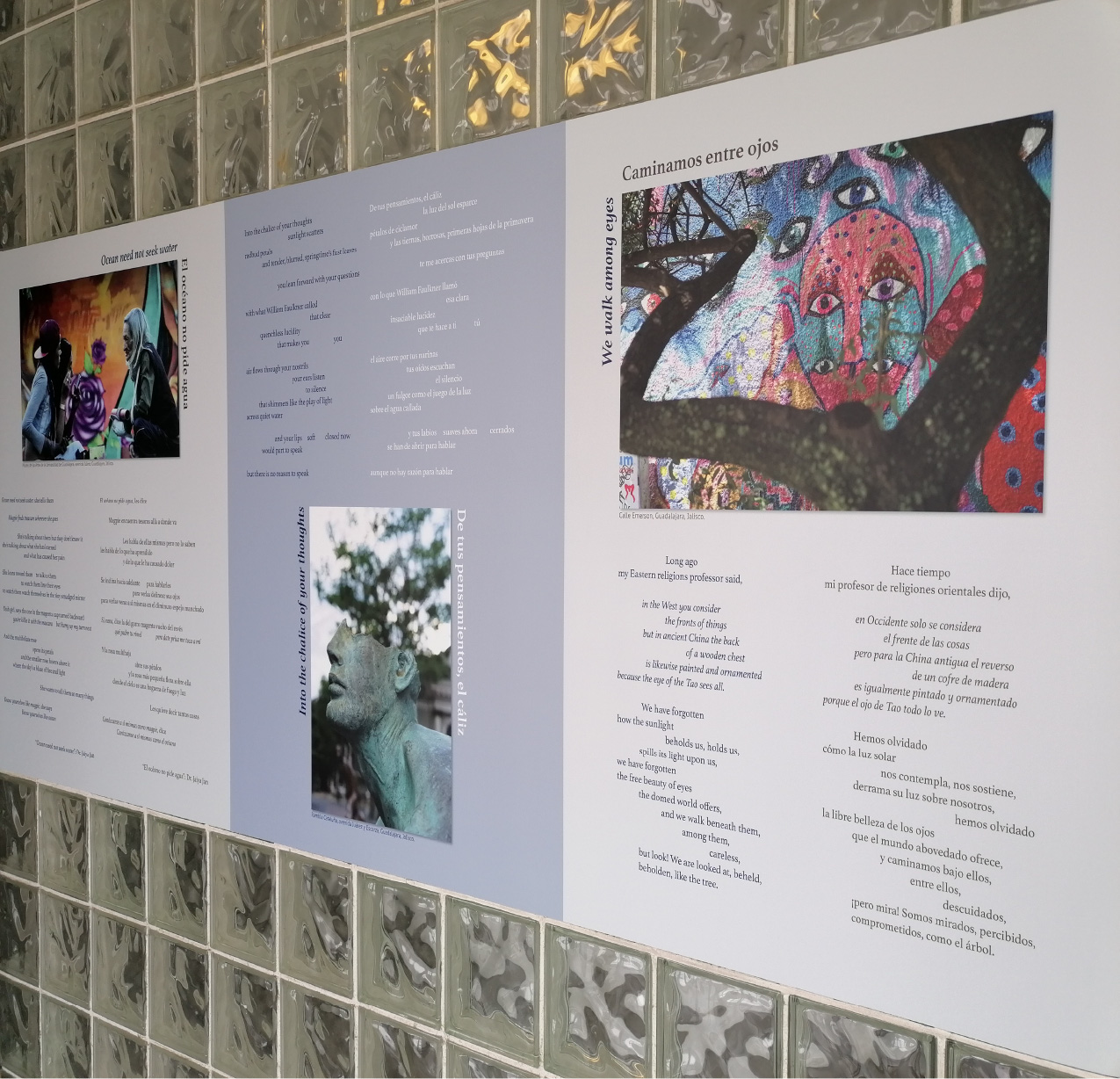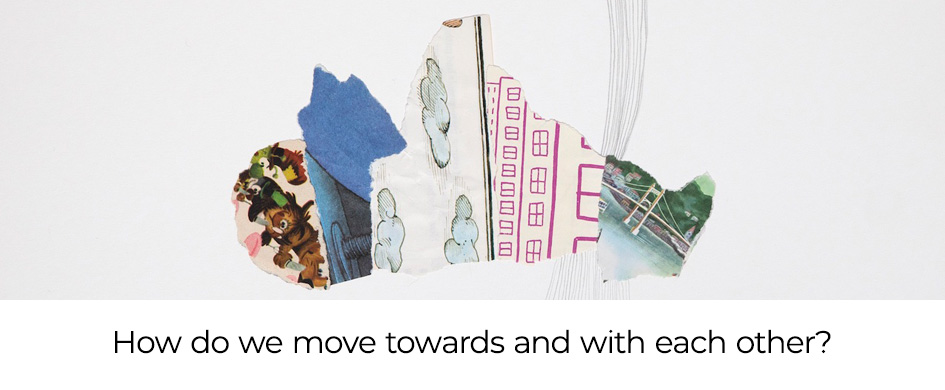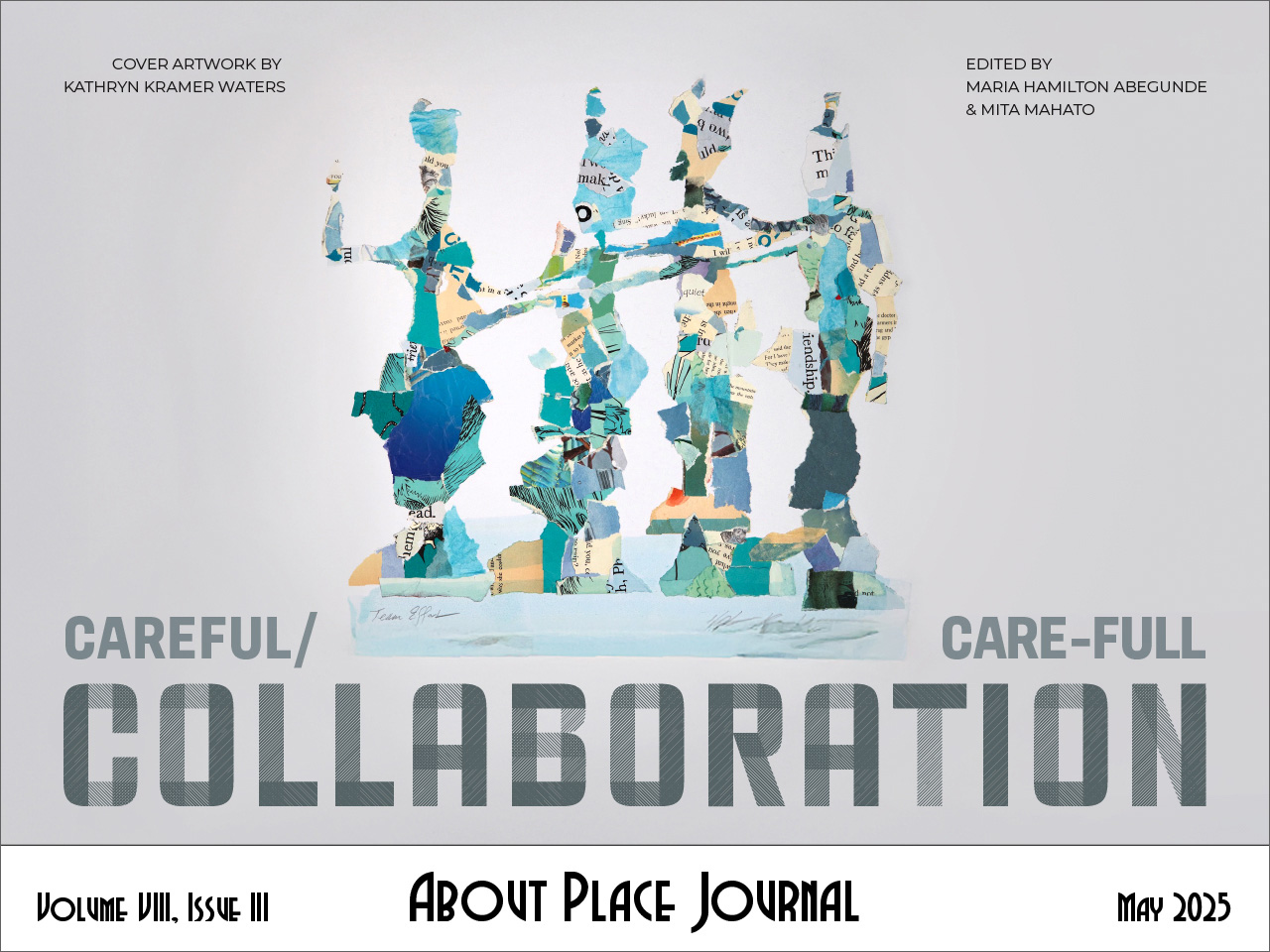Into the Chalice of Your Thoughts /
De tus pensamientos, el cáliz:
A Journey into Collaborative Creativity
What might emerge from the collaboration between a photographer and a poet? In December of 2022, poet Ann Fisher-Wirth received an email from her former graduate student and longtime friend, Wilfried Raussert, asking if she would like to write some poems to accompany photographs he was taking on the streets of his second home, Guadalajara. Seeing how evocative and beautiful the photographs were, she happily agreed, and over the next months they sent work back and forth.
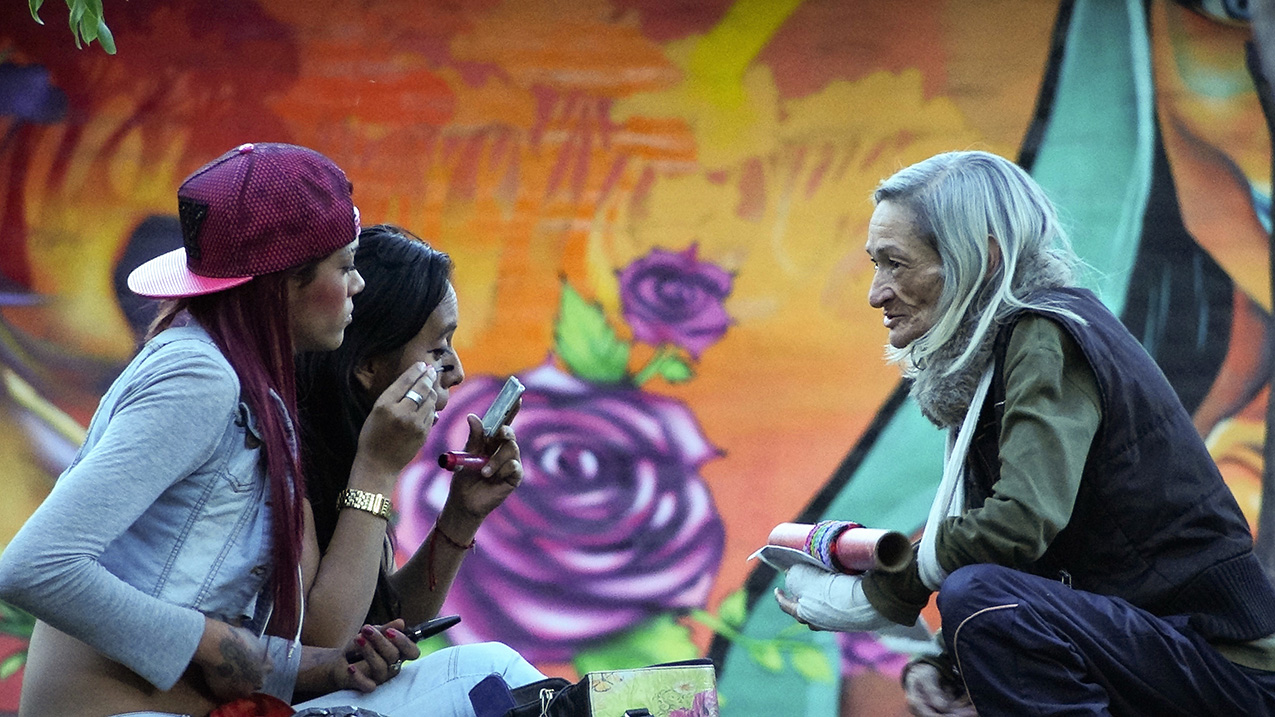
| Ocean need not seek water, she tells them | ||||||||||
| Magpie finds treasure wherever she goes | ||||||||||
| She’s talking about them but they don’t know it | ||||||||||
| she’s talking about what she has learned | ||||||||||
| and what has caused her pain | ||||||||||
| (look at the bandaged hand the sling) | ||||||||||
| She leans toward them to talk to them | ||||||||||
| to watch them line their eyes | ||||||||||
| to watch them watch themselves in the tiny smudged mirror | ||||||||||
| Yeah girl, says the one in the magenta cap turned backward | ||||||||||
| you’re killin it with the mascara | ||||||||||
| but hurry up my turn next | ||||||||||
| And the multifoliate rose | ||||||||||
| opens its petals | ||||||||||
| and the smaller rose hovers above it | ||||||||||
| where the sky’s a blaze of fire and light | ||||||||||
| She wants to tell them so many things | ||||||||||
| Know yourselves like magpie, she says | ||||||||||
| Know yourselves like ocean | ||||||||||
| (“Ocean need not seek water”: Dr. Jaiya Jan) | ||||||||||
| ~~~ | ||||||||||
| El océano no pide agua, les dice | ||||||||||
| Magpie encuentra tesoros allá a donde va | ||||||||||
| Les habla de ellas mismas pero no lo saben | ||||||||||
| les habla de lo que ha aprendido | ||||||||||
| y de lo que le ha causado dolor | ||||||||||
| (mira la mano vendada el vendaje) | ||||||||||
| Se inclina hacia adelante para hablarles | ||||||||||
| para verlas delinear sus ojos | ||||||||||
| para verlas verse a sí mismas en el diminuto espejo manchado | ||||||||||
| Sí, nena, dice la del gorro magenta vuelto del revés | ||||||||||
| qué padre tu rímel | ||||||||||
| pero date prisa me toca a mí | ||||||||||
| Y la rosa miltihoja | ||||||||||
| abre sus pétalos | ||||||||||
| y la rosa más pequeña flota sobre ella | ||||||||||
| donde el cielo es una hoguera de fuego y luz | ||||||||||
| Les quiere decir tantas cosas | ||||||||||
| Conózcanse a sí mismas como magpie, dice | ||||||||||
| Conózcanse a sí mismas como el océano | ||||||||||
| (“El océano no pide agua”: Dr. Jaiya Jan) | ||||||||||
Then, during the summer of 2023, Ann and Wilfried began to meet weekly over Zoom with members of the 4W-Women in Translation Circle, led by Sarli E. Mercado, to translate the poems into Spanish.
Women in Translation (WIT) is a project of the 4W Initiative (Women and Well-Being in Wisconsin and the World) of the School of Human Ecology at the University of Wisconsin-Madison, founded by Sarli and Lori DiPrete Brown. Beginning in 2018, the circle began to work in collaboration with the Environmental Sciences Museum of the University of Guadalajara headed by Eduardo Santana, to translate winners of the “José Emilio Pacheco City & Nature Literature Award” in poetry and short story, which led to the publication of Montañas and Three or Four Ríos (2022), and a fruitful ongoing partnership. Wilfried, who is affiliated with the Maria Sybilla Merian Center for Advanced Latin American Studies (CALAS) in Guadalajara, reached out to Eduardo, who invited the 4W-WIT circle to translate the poems.
Over the summer of 2023, Into the Chalice of Your Thoughts / De tus pensamientos el calíz became a book-length manuscript seeking answers to the troubled relationship between nature, culture, and the human in the age of the Anthropocene. Sarli led the collective translation of Ann’s poems into Spanish in a series of virtual gathering of translators, scholars, and writers. The group included Lori DiPrete Brown, Juan F. Egea, Silvia Goldman, Olmanda Hernandez Guerrero, Vicente M. López Abad, Sarli E. Mercado, and Sally Perret. Meanwhile, Wilfried (CALAS Guadalajara-Bielefeld) and Eduardo with his museum team Gabriela Vaca Medina, Abril Ambriz Cardenas, and Paola Palacios tested and developed concepts for an exhibition containing posters of the images and poems in the Cultural Center and the Library Juan José Arreola of the University of Guadalajara.
The book was designed by FARA in Guadalajara and published by the University of Guadalajara Press in the fall of 2023. The project was presented at the Guadalajara International Book Fair, the second-largest book fair in the world, that November. Fortunately, and fulfilling for all, several of the collaborative partners were able to participate in the inauguration of the exhibition and the book presentation.
The project continued to grow in 2024 with Ann and Wilfried collaborating on new pairs of poems and images, and Sarli and Sally guiding a new group of translators that included José Bañuelos Montes, Ana Varela Tafur, and Ulises Bonifacio Zarazúa. In November 2024, Ann held a public poetry reading presenting an extended version of Into the Chalice of Your Thoughts / De tus pensamientos, el cáliz at the University of Wisconsin-Madison. Sarli, Lori, and Ann conducted a poetry translation workshop following the event, and Wilfried participated online in the presentation of new pairs of poems and images, read collectively in English and Spanish, by commenting on his photography as a painterly art and dialog between photography and street art from the Americas.
In January 2025, The Department of Modern Languages at the University of Guadalajara selected 12 pairs of poems and images as permanent exhibition material for the university campus Belenes in Guadalajara. In February 2025, 10 pairs of poems and images were selected by Patricia Pérez and the designer team of UNAM University for a new exhibit of Into the Chalice of Your Thoughts / De tus pensamientos, el cáliz in Mexico City. Currently, Ann and Wilfried are completing an extended book manuscript for publication on the American market.
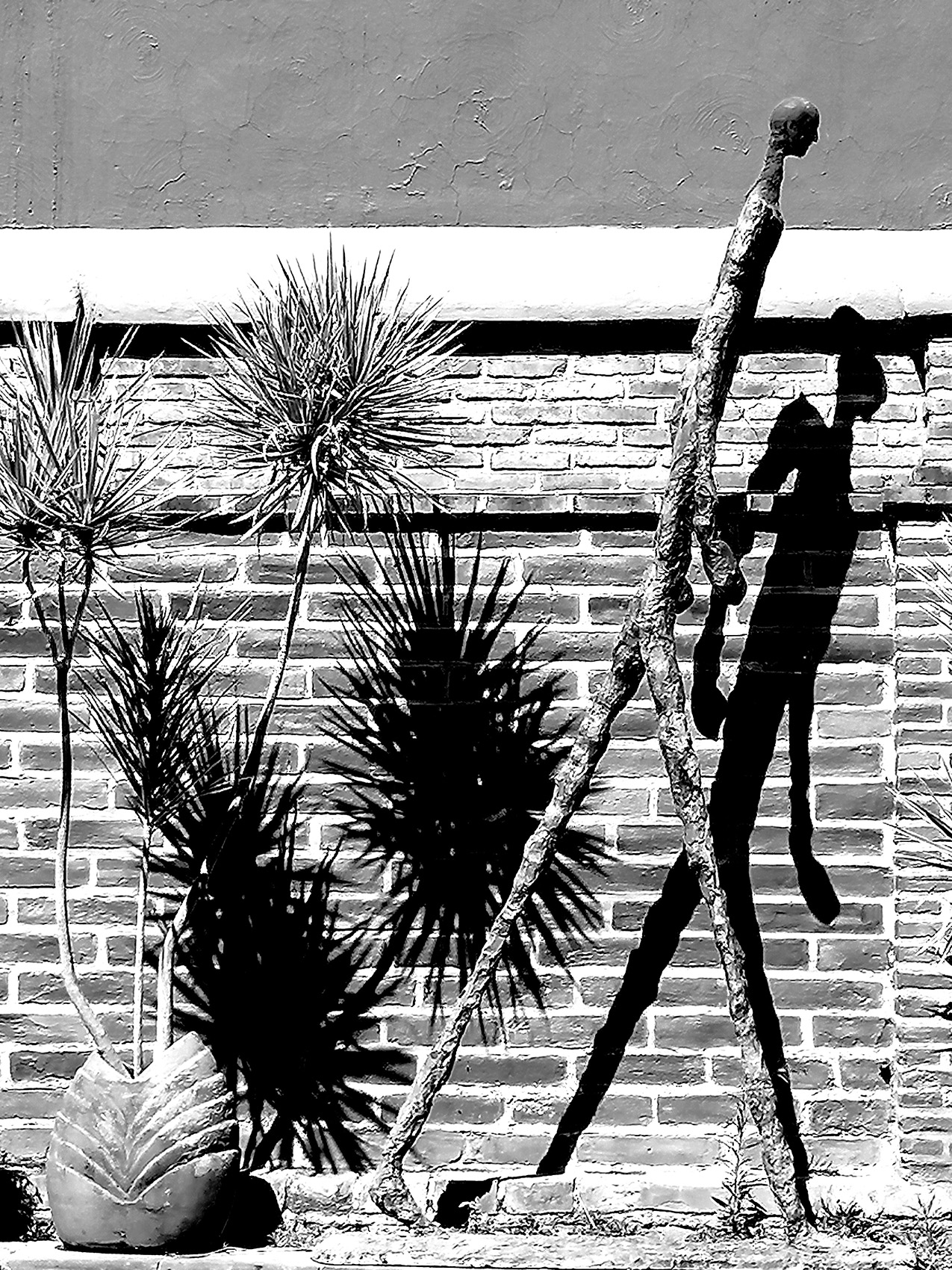
| I have no words | |||||||||
| I walk away | |||||||||
| following my shadow | |||||||||
| leaving the spiny branches | |||||||||
| and their spiny shadows | |||||||||
| behind me | |||||||||
| I am content | |||||||||
| to move through | |||||||||
| the intricate patterns | |||||||||
| and if you would run your fingers | |||||||||
| along the rough bricks | |||||||||
| along the grainy mortar | |||||||||
| between the bricks | |||||||||
| along my obdurate body | |||||||||
| if you would consent to be | |||||||||
| pierced | |||||||||
| by the needle-sharp leaves | |||||||||
| you would find | |||||||||
| there is no gentleness | |||||||||
| here in the harsh sun | |||||||||
| whom I adore | |||||||||
| who gives me strength | |||||||||
| in my renunciation | yes I know | ||||||||
| what love is | yes I know what it is | ||||||||
| to whisper with the one you love | |||||||||
| on an April afternoon | |||||||||
| when the jacarandas are blooming | |||||||||
| outside the gauzy curtains | |||||||||
| but this too is truth | |||||||||
| this too | |||||||||
| is beautiful | |||||||||
| not sorrow | just silence | ||||||||
| ~~~ | |||||||||
| No tengo palabras | |||||||||
| me alejo | |||||||||
| persigo mi sombra | |||||||||
| dejo atrás ramas espinosas | |||||||||
| y sus espinosas sombras | |||||||||
| detrás de mí | |||||||||
| satisfecho | |||||||||
| de transitar entre | |||||||||
| los laberintos de la luz | |||||||||
| y si deslizaras tus dedos | |||||||||
| por la aspereza del muro | |||||||||
| por el relieve de la argamasa | |||||||||
| entre los ladrillos | |||||||||
| junto a mi obstinado cuerpo | |||||||||
| si consintieras ser | |||||||||
| perforado | |||||||||
| por las hojas puntiagudas | |||||||||
| descubrirías | |||||||||
| que no hay indulgencia | |||||||||
| bajo el sol abrasador | |||||||||
| al cual adoro | |||||||||
| que me fortalece | |||||||||
| en mi renuncia | sí sé | ||||||||
| lo que es el amor | sé lo que es | ||||||||
| susurrarle | |||||||||
| a quien amas | |||||||||
| una tarde de abril | |||||||||
| cuando las jacarandas florecen | |||||||||
| afuera tras las diáfanas cortinas | |||||||||
| pero también esto es verdad | |||||||||
| también esto | |||||||||
| es hermoso | |||||||||
| no es pena | solo silencio | ||||||||
Eduardo Santana: What are the possibilities of collaborative creativity?
Ann: For about the last fifteen years, I have been engaged in various collaborative projects. With Laura-Gray Street, I coedited The Ecopoetry Anthology (2013) and Attached to the Living World: A New Ecopoetry Anthology (2025), and with Laura-Gray and regional coeditors Mildred Barya, Juan Carlos Galeano, Craig Santos Perez, and Esther Vincent Xueming, I coedited an issue of the journal Global South on ecoarts from Africa, Asia, Latin America, Oceania, and the US South (2023). My fifth book of poems, Mississippi (2018), is a collaboration with the Mississippi Delta photographer Maude Schuyler Clay. All these projects have given me great pleasure and have, I think, evidenced the power of collaboration not only to inspire the collaborators but also to collect and create work that stimulates environmental awareness and a concern for social justice.
The same has been true for Into the Chalice of Your Thoughts. Wilfried’s photographs of street art capture vivid, dreamlike images of everyday people in Guadalajara. The members of the Women in Translation team, who come together from many places in several countries, have enormously impressed me with their ability to work together—and to work with Wilfried and me—with warmth and respect. And getting to take the project to Guadalajara and display it at the Guadalajara Book Festival, to spend time with Wilfried and his partner Yolanda, and to meet Eduardo, Abril, and others was a rare privilege and honor. Now, as Into the Chalice of Your Thoughts / De tus pensamientos el cáliz has continued to travel and grow, we look forward to offering this collaboration to all who may be moved by its urgency and beauty.
Wilfried: My first experience with creative collaboration goes back to my years with a traveling theatre group in the South of Germany in the late 1970s and early 1980s. Our plays were addressing social and political issues of the times. Working, performing, and traveling together established bonds of friendship that last until today. For about the last twenty years, I have been engaged in various collaborative projects. With Giselle Anatol, Sarah Corona Berkin, José Carlos Lozano, and Sebastian Thies, I coedited the Routledge Handbook to Culture and Media (2020) that included more than sixty contributors from all over the world. For almost twenty years as principal editor I have worked with a team of seven additional editors and frequent guest editors to publish the editions of the online journal fiar forum for inter-american research dedicated to hemispheric studies of American cultures. I collaborated with poet Ketaki Datta (India) on a photography-poem collage Urban Reflections (kipu 2018); with the Mexican novelist Gerado Cham on Crónicas Urbanas (Ediciones de la Noche), a collage of photography and urban sketches; and with the Canadian poet Afua Cooper on Black Matters (Roseway 2020), a photography-poetry dialog about urban black life that won several awards in Canada. All these projects have provided me with new knowledge, friendships, and pleasures. I feel that all these projects have demonstrated that collaborative creativity enriches all contributors and underscores the power of artistic creativity as a force for social change and improvement.
The same has been true for Into the Chalice of Your Thoughts. With Ann, former supervisor of my PhD thesis, I have established a long-lasting friendship. I was also very glad to meet Ann’s husband Peter Wirth again in Guadalajara. Ann’s poems are thoughtful, contemplative, thought-provoking, experimental in form. With Ann, I developed a true dialog based on mutual respect and admiration. To work with her and the museum team (Eduardo, Abril, Gaby, Paola), as well as the long-distance exchanges with Sarli, Sally, and other translators, brought new friends and inspiration into my life. Creative collaboration is indeed community-building and fosters true communication across borders. As the exhibition in Mexico City shows, the networks keep expanding so that words, imagination, and images can travel to reach further audiences.
Sarli: I am one of the co-founders of Living Poetry: Women in Translation (4W-WIT), a community and academic research-to-practice initiative led by women and part of the broader Women and Wellbeing in Wisconsin and the World Initiative at the University of Wisconsin-Madison (4W Initiative) led by my colleague Lori DiPrete Brown. For me, it was an honor to lead this project of translating Ann’s poems in dialogue with Wilfried’s photographs into Spanish. Founded in 2018, the translation group 4W WIT was born through a collaboration with the award-winning writers of the José Emilio Pacheco City and Nature Literary Prize created and overseen by the Museum of Environmental Sciences at the University of Guadalajara (MCA). In our collaboration with the Museum of Environmental Sciences of the University of Guadalajara, Meninas Cartoneras Editorial in Spain, and the Latin American and Caribbean and Iberian Studies Program at UW-Madison, we had the honor of creating the bilingual anthology Montañas and Three or Four Ríos (2022). A five-year project, this collection includes the poetry and short stories by the award-winning writers of the José Emilio Pacheco City and Nature Literary Prize. Our goal is to introduce the artistic vision of these authors, who belong to a new generation of Latin American writers, to the English-speaking world. In so doing, we also aim to express concerns and provide some insight into humanity’s ability to create alternative relationships with our surroundings and our planet.
This translation with Ann’s poems was truly a gathering of voices, a journey through territories of words, a crossing of many borders, boundaries where we go in search of music, rhythm, and the precise image lingering in our thoughts. We arrived at a semantic crossroads, juggling words, as though arriving at a “zone of cultural contact” where verse and photography met—as did Mexico, Venezuela, Uruguay, Spain, Nicaragua, Germany, and the United States. And in the company of Ann, it was a dialogue filled with laughter and joy, a dialogue where our voices became poetry.
Sally: I joined WIT during the pandemic. I was invited to talk about the project I was working on with José Bañuelos Montes, Voces de la resistencia: Una antología de voces afrocolombiano. I loved the way the group interacted and I was invited to continue attending. So, I did. In the summer of 2023, I was asked if I wanted to join a sub-group, if you will, to translate Into the Chalice of Your Thoughts, and so began a wonderful adventure into words and images.
It has been such an honor and a privilege to form part of this project. Having Ann in our sessions and being able to return to Wilfried’s images for guidance enriched our dialogues, helping us to arrive at the most satisfying translations. I love when someone offers a word and it is exactly what we were looking for. It is a process that brings us closer not only to each poem and the many feelings they conjure, but also to the power of language to influence how we understand the world. Whether we see branches or ideas branching can change how we see the forest and its trees.
Collaboration with WIT has always been about the joy of words (and now images with words) for me. No matter what life has thrown at me, I can count on WIT to provide a space for us to focus on what makes the world beautiful: mutual comprehension. Communication is not just one side (we speak, we utter), but it is also heard. Being part of a group whose mission is to play with words from one language to another has helped me to understand better the importance of being seen and heard, not just for the roles I play, or the situations in which I live, but for the pure joy of words.
Eduardo: How has or can photography, especially urban street photography, induce action to transform society for the better?
Wilfried: I think that photography makes us see the world around us more consciously. Beyond pure documentation of street art, photography can add an artistic and semiotic level to read street art as related to people, nature, and the urban environment. I feel that a sense of connectedness heightens the awareness of mutual dependencies.
Eduardo: What is the social and inspirational role or effect of photography?
Wilfried: Historically, photography has served purposes of documentation. But we have a long trajectory of photography as art, too. Here I see the greatest potential of inspiration since photography permits us to create new worlds and new perspectives on the world by experimental visual narratives.
Eduardo: How important has photography been in inspiring this poetry?
Ann: I love working ekphrastically; it seems to free my imagination so that words come effortlessly in response to the visual images. With regard to Willie’s photos—sometimes my poem is a meditation upon the image, sometimes my poem speaks to or comments upon the image in the photograph, and at other times my poem is as if the image in the photograph is speaking. I love the dialogue that is established between the visual image and the dimension of language, with all the elements—rhythm, imagery, sound patterns, inhabitation on the page, and so forth—that make the language poetry.
Eduardo: Can poetry induce concrete social action?
Ann: Poetry can lead to social action, though that was not my purpose in writing the poems in Into the Chalice of Your Thoughts. The question is very complicated; there are poems—and poets—that have led to social action, for instance, Carolyn Forché’s book The Country Between Us, which back in the 1980s helped cause changes in US foreign policy toward El Salvador. But in general, I’d say that if my poems lead to social action, it is because they help readers or listeners see more clearly and therefore feel more deeply about the human and other-than-human world around them. What we do not see, we do not value, and what we do not value, we do not act to cherish or preserve.
Sarli and Sally (representing WIT): Collaborating has opened many doors, beginning with the exposition of the photographs, poems, and translations in Guadalajara in November of 2023. It was a joy and an honor for 4W WIT to collaborate with our colleagues from MCA and The Maria Sibylla Merian Center for Advanced Latin American Studies in the Humanities and Social Sciences (CALAS) at the University of Guadalajara. The dialogue between Ann and Willy’s work, a translation in and of itself of images into words, allows us to flow between boundaries and change perspectives and to look deeply into our present human condition, underlined by war, hunger, alienation, death, and grief—all linked to our current multiple crises (political, social, public health, and environmental).
Their invitation to translate Into the Chalice of Your Thoughts took us into a place of deep reflection, inspiration whence to seek transformation and other ways to see, live, and connect with our surroundings. We recognized the interconnectedness of all that exist, all that is urban yet rural, artificial yet natural, singular yet plural. “[W]hat to make of the storefront world / and the man / who shoulders three black plastic trash bags / . . . / edges of boxes poking against the plastic?” Empire, Ann tells us as well, “swells, history is made / in a collusion of whispers,” while we observe photographed murals of a woman’s beautiful brown face ignored by the passerby, or of a man, surrounded by branches and leaves, who stares into the distance. These are murals, images, and words that are part of that collusion of whispers that narrate a different History.
As we reflect on them, Kenyan novelist Ngugi wa Thiong’o’s call for a Globalectic, or a global-ethic reading of works of art, comes to mind: that is, a reading that “should bring into mutual impact and comprehension the local and the global, the here and there, the national and the world.” It is also a way to read the images and poems “with the eyes of the world” and to “see the world with the eyes of the text” (Globalectics: Theory and the Politics of Knowing).
With our thanks to Ann and Wilfried and to our colleagues at the University of Guadalajara, we invite you to enjoy this poetic celebration, which is also the celebration of our resilience and of the sacred that is everywhere among us. And above all, to let our thoughts become a chalice.
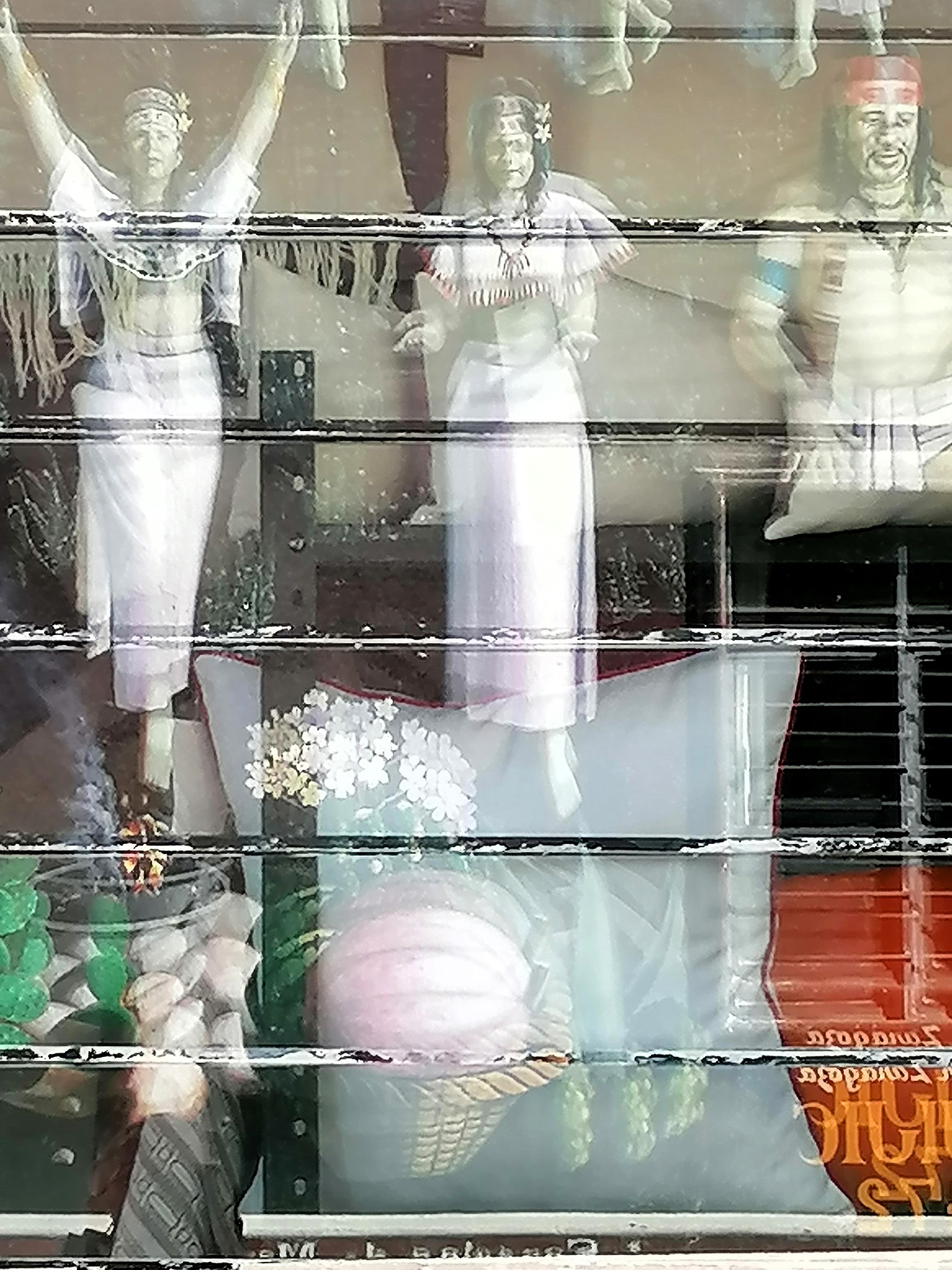
| They approach, triumphant with flowers in their hair | |||||||||
| Harvest has been good, look | |||||||||
| at their smiles, that woman’s lifted arms | |||||||||
| as if to call the vivid sky down or soar | |||||||||
| upward, her comadre’s | |||||||||
| open hands extended waist-high, | |||||||||
| the smile and ample belly | |||||||||
| of the man who celebrates beside them, they have | |||||||||
| adorned their bodies with white cloths, necklaces, | |||||||||
| headbands, they come forward, | |||||||||
| they give thanks, earth has blossomed, | |||||||||
| blossoms have fruited | |||||||||
| and the gourds swelled | |||||||||
| so heavy they nearly burst their baskets | |||||||||
| We see also in the window a pillow | |||||||||
| where if you have grown tired from harvesting | |||||||||
| you may lay your head | |||||||||
| In this town of the brilliant murals | |||||||||
| of parrots and saints, iguanas and dragons, above the celebrants | |||||||||
| float the feet of other dancers | |||||||||
| ~~~ | |||||||||
| Se acercan, triunfantes con flores en el cabello | |||||||||
| La cosecha ha sido buena, mira | |||||||||
| sus sonrisas, los brazos en alto de esa mujer | |||||||||
| como si invocara al cielo vivo o remontara el vuelo | |||||||||
| en ascenso, las manos | |||||||||
| abiertas de su comadre extendidas cintura-arriba, | |||||||||
| la sonrisa y el amplio vientre | |||||||||
| del hombre que celebra a su lado, se han | |||||||||
| adornado el cuerpo con trajes blancos, collares, | |||||||||
| diademas, se acercan, | |||||||||
| dan gracias, la tierra ha florecido, | |||||||||
| las flores han germinado | |||||||||
| y las calabazas henchidas | |||||||||
| pesan tanto que casi rebosan sus cestas | |||||||||
| Vemos también en la ventana una almohada | |||||||||
| donde por si te has cansado de la cosecha | |||||||||
| puedes reposar la cabeza | |||||||||
| En este pueblo de brillantes murales | |||||||||
| de loros y santos, de iguanas y dragones, sobre los que festejan | |||||||||
| flotan los pies de otros bailarines | |||||||||
One panel of the exhibition currently at UNAM University in Mexico City.
